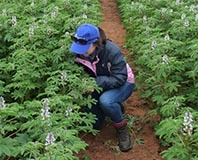Read the latest information on
Foot-and-mouth disease

Vigilant monitoring can make all the difference to the outcome of an incursion, or outbreak of a regionalised pest or disease.
Three recent pest incursions have highlighted the benefits of early detection in containing and eradicating exotic pests.
Last year saw the first report of Russian wheat aphid (RWA) in Australia, an incursion of khapra beetle in South Australia, and the outbreak of lupin anthracnose in commercial lupin crops for the first time in NSW.
Vigilant monitoring played a significant role in the early detection and eradication of khapra beetle. The beetle was confined to products on a small number of properties, and the point of entry to the country could be traced directly
Monitoring also played a major role in the detection of lupin anthracnose, which was detected during routine crop inspections by an agronomist.
RWA, on the other hand, which was found during general surveillance crop monitoring, was not found early enough to be successfully contained or eradicated. Following its initial detection, targeted surveillance found it to be widely distributed in SA. It was also found in Victoria, then eventually in southern NSW and, more recently, in Tasmania.
Beyond biosecurity inspections at the border, people in the field such as agronomists and growers are the first line of defence in detecting new pests and diseases.
If you frequently inspect crops, or have an agronomist, researcher or service provider do it for you, the Grains Farm Biosecurity Program needs your help. The program’s five grains biosecurity officers have established surveillance networks that include agronomists, researchers and grain handlers who watch for exotic pests.
Olivia Dawson, a Condobolin-based agronomist, has been doing surveillance for the past few seasons.
“It doesn’t create lots of extra work as we incorporate it into our normal crop inspections by keeping an eye out for a couple of key pests and diseases such as barley stripe rust, as well as anything that looks unusual,” said Ms Dawson.
By inspecting crops frequently, you are already conducting general surveillance. The main objective of collecting the monitoring data obtained from surveillance is to contribute to Australia’s evidence for the absence of certain pests and diseases, which helps to maintain domestic and international grain markets.
Regular monitoring also helps detect pests early if they have slipped through our border biosecurity, hitchhiked into the country on a visitor, or moved in from another state.
If you are interested in helping to protect your industry, you can contact your state grains biosecurity officer.
New South Wales
Bill Gordon | billy.gordon@dpi.nsw.gov.au
0428 133 944
Queensland
Kym McIntyre | kym.mcintyre@daf.qld.gov.au
0429 727 690
South Australia
TBA
Victoria
Jim Moran | jim.moran@ecodev.vic.gov.au
0418 377 930
Western Australia
Jeff Russell | jeff.russell@dpird.wa.gov.au
0447 851 801
Acknowledgement: Reproduced from an article published in GRDC’s Ground Cover magazine